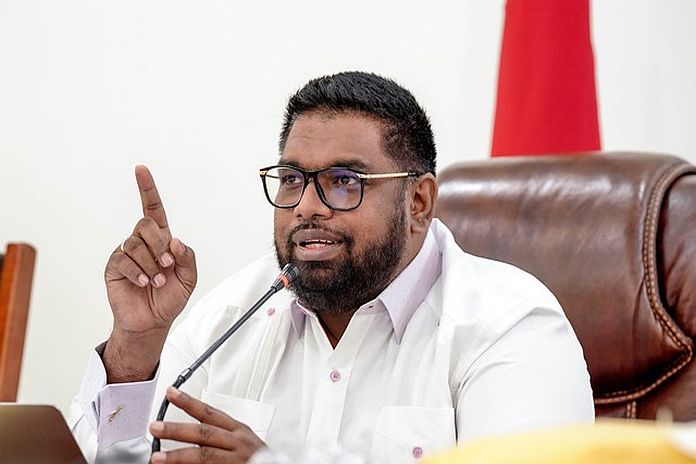By Caribbean News Global contributor
GEORGETOWN, Guyana – His Excellency Dr Irfaan Ali, on Monday, reiterated the importance of agriculture and food production, and a government that is open to doing business, delivered an address to approximately 150 US companies interested in doing business in Guyana, at the second edition of the Business Webinar Series to US businesses, organised by the United States Department of Commerce and the US Embassy in Guyana.
Pointing to the government of Guyana plans to facilitate the growth and development of the sector, president Ali said, “Guyana is open to doing business – it is ready to facilitate growth and development,” moreover, “the government is ready to help private investment to ensure a decent return—a country and a market that believe inherently in the participation of the private sector.”
President Ali outlined Guyana’s potential to produce a large portion of the food requirements for CARICOM, noting its proximity to one of the most dynamic and robust agricultural sectors by diversification in the world [Brazil] and the under-investment of the sector in realising its full potential.
“Agriculture contributes 21.7 percent of Guyana’s non-oil GDP; and in terms of agriculture trade, the country’s export earnings are about US$370 million which primarily comes from rice, fish, sugar, and some amount of non-traditional produce; while the sector contributes to about 12.1 percent of employment,” noting that although employment in the sector is the highest in rural areas, a lot of investments have been made in research, technology development and skills development which have produced “a very competent skill base” in terms of human assets available, “about 5 percent of the country’s national budget is allocated to agriculture.”
President Ali disclosed to potential investors that Guyana produces 59 percent of its internal demand, in keeping with what Guyana offers, of its “215,000 square kilometres of coastline, an ideal location to access global markets, attractive fiscal incentives for investment, a private-sector friendly government and of course, a country with diverse people.”
In addition president Ali outlined some investment opportunities in rice, sugar, corn, soya, coconut, spices, fruits and vegetables, agro-processing, agrochemical, the livestock sector (poultry, beef, dairy, sheep, and goat) and fisheries-agriculture and shrimp.
With regards to Guyana’s productive capacity within CARICOM, president Ali noted, that the potential is about US$25 million in poultry alone, 90 percent of which is imported.
“Guyana has the potential of satisfying all of CARICOM’s food requirement for poultry products, eggs, beef, aquaculture; we have the land, we have the freshwater but what we don’t have is the investment. What we don’t have are the large scale mega-farms that would allow us to produce, that would allow us to facilitate the type of growth that will help us to enter this natural market in CARICOM,” said president continued. “What we need, are the investors who are ready to make the investments into large-scale mega facilities that will support the growth and development of these different sub-sectors. In terms of land availability, in every one of these areas, we have lands that are available. We have freshwater … and we have the critical infrastructure link that will allow you to move your produce from the field to the market and/or the export facility as it is now.”
The government of Guyana is heavily focused on developing the aquaculture sector in the short term to service potential markets including CARICOM, the USA, Mexico, and the EU.
“The USA, for example, imported over 550,000 metric tons of frozen shrimp and prawns valued at US$4.8 billion. So here is an opportunity for us to work together with the local private sector and the US investors to meet the demand in the United States. And what do we have for the aquaculture industry? We have the brackish water, we have fresh water and salted water, all of which are distinct and comparative advantages in the aquaculture industry.”
In addition, president Ali outlined that Guyana’s comparative advantage in the sector is 2.15 percent times higher than any other South American county’s comparative advantage, including that of powerhouse producers Brazil.
“Again, like the other sectors, the government provides a comprehensive list of tax breaks, fiscal incentives, drainage and irrigation support, infrastructure support; I want to say to you that Guyana has also taken back the lead role in agriculture for the region, that is the CARICOM region, and for the purposes of moving forward, we welcome you and your investment to a safe investment destination.”
President Ali also answered questions from potential investors on several key areas of his presentation, including access to freshwater resources, electricity cost reduction, the use of agro-technology and access to electricity for the agriculture sector.
“Historically this has been one of the most inhibiting factors for us to develop our country – the cost of electricity. Right now, all of our electricity is supplied through heavy fuel oil (HFO). That will change tremendously over the medium to long term. We are now developing an energy mix that will include natural gas, solar, wind, and the plan is to have an energy strategy that would create a new energy corridor between Guyana, Brazil and Suriname. So, you will see the cost of energy-reducing because of the investment we will be making.”
– With a file from (DPI)





